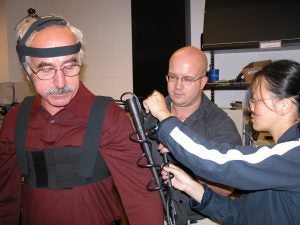Professor develops virtual reality-based course

East Carolina University Graduate students James Crouch and Xiaozheng Yao assist Professor Moha Tabrizi as he tries on a body motion capture device, a set of sensors that tracks movements of the human body.
When Professor Moha Tabrizi tried on his new sensory suit in East Carolina University’s Technology Innovation Lab, he wasn’t looking to create a movie or video game for Nintendo or Xbox, although the technology is similar.
Instead, the ECU professor of computer science was tracking his motions in order to create a virtual version of himself for an online class that will debut on a pilot basis for the spring 2006 semester.
“We are not using this technology for its original use — movies and video or computer games,” Tabrizi said. “Rather, we are recreating the use of the technology for education.”
The technology aids an emerging medium known as Agent and Virtual Reality-based online course delivery system, which has also been applied to computer game and entertainment systems development. Tabrizi is using the technology to create a virtual classroom where students can view lectures online in an environment that mimics a face-to-face classroom setting.
The suit — made up of interacting black PVC piping, motion trackers, facial trackers and gloves — utilizes the same technology that movie and video game creators use to track the natural movement of characters such as athletes in order to create 3-D environments. The suit is worn to collect the necessary data, but not every time a lecture is presented. The recorded movements of the virtual professor are then re-created in the 3-D environment.
“It’s an interactive and multi-media-based approach similar to computer gaming instead of just reading online or viewing video,” Tabrizi said.
The system fuses different technological elements, including a 3-D platform, a course management system, an electronic whiteboard and a slide presentation.
The professor appears as an animated character. Lectures can be archived for students to use later.
The growing trend toward online education is apparent at universities around the country, including ECU, which boasts about 4,500 distance education students. While the instruction is equivocal to a face-to-face class, Tabrizi notes a discrepancy between the two forms. The AVR is one of the first steps in yielding enhanced systems for delivery of online courses, Tabrizi said.
“In online education sometimes the student and the instruction connection is missing,” he said. “With this innovative technology, we aim to solve the environmental connection. We are trying to bring face-to-face interaction to online instruction.”
Tabrizi said he has found that students prefer to observe and hear the professor, ask questions and read materials with multimedia content.
“Despite recent efforts to integrate video-conferencing into existing online course delivery systems, they do not produce an environment resembling the face-to-face setting,” he said.
Moreover, he said, adding video to existing systems increases the network bandwidth considerably and reduces the capabilities of these systems in areas with slow network infrastructure.
Tabrizi said the Agent and Virtual Reality-based communication architecture was created to optimize bandwidth usage so that the project can deliver online education to underserved areas that do not have cable or broadband Internet access.
“This innovative technology is being created in such a way that the bandwidth requirement is reduced tremendously,” he said. “An interactive lecture with a full screen can be received in real time or archived, regardless of the type of network connection, including dial-up.”
Further applications of the AVR system include the training of workers in hazardous material handling environments, medical clinics and surgery.